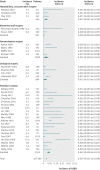Burden of adhesions in abdominal and pelvic surgery: systematic review and met-analysis
- PMID: 24092941
- PMCID: PMC3789584
- DOI: 10.1136/bmj.f5588
Burden of adhesions in abdominal and pelvic surgery: systematic review and met-analysis
Abstract
Objective: To estimate the disease burden of the most important complications of postoperative abdominal adhesions: small bowel obstruction, difficulties at reoperation, infertility, and chronic pain.
Design: Systematic review and meta-analyses.
Data sources: Searches of PubMed, Embase, and Central, from January 1990 to December 2012, without restrictions to publication status or language.
Study selection: All types of studies reporting on the incidence of adhesion related complications were considered.
Data extraction and analysis: The primary outcome was the incidence of adhesive small bowel obstruction in patients with a history of abdominal surgery. Secondary outcomes were the incidence of small bowel obstruction by any cause, difference in operative time, enterotomy during adhesiolysis, and pregnancy rate after abdominal surgery. Subgroup and sensitivity analyses were done to study the robustness of the results. A random effects model was used to account for heterogeneity between studies.
Results: We identified 196 eligible papers. Heterogeneity was considerable for almost all meta-analyses. The origin of heterogeneity could not be explained by study design, study quality, publication date, anatomical site of operation, or operative technique. The incidence of small bowel obstruction by any cause after abdominal surgery was 9% (95% confidence interval 7% to 10%; I(2)=99%). the incidence of adhesive small bowel obstruction was 2% (2% to 3%; I(2)=93%); presence of adhesions was generally confirmed by emergent reoperation. In patients with a known cause of small bowel obstruction, adhesions were the single most common cause (56%, 49% to 64%; I(2)=96%). Operative time was prolonged by 15 minutes (95% confidence interval 9.3 to 21.1 minutes; I(2)=85%) in patients with previous surgery. Use of adhesiolysis resulted in a 6% (4% to 8%; I(2)=89%) incidence of iatrogenic bowel injury. The pregnancy rate after colorectal surgery in patients with inflammatory bowel disease was 50% (37% to 63%; I(2)=94%), which was significantly lower than the pregnancy rate in medically treated patients (82%, 70% to 94%; I(2)=97%).
Conclusions: This review provides detailed and systematically analysed knowledge of the disease burden of adhesions. Complications of postoperative adhesion formation are frequent, have a large negative effect on patients' health, and increase workload in clinical practice. The quantitative effects should be interpreted with caution owing to large heterogeneity.
Registration: The review protocol was registered through PROSPERO (CRD42012003180).
Conflict of interest statement
Competing interests: All authors have completed the ICMJE uniform disclosure form at
Figures









Comment in
-
Adhesions in abdominal and pelvic surgery: benefit of laparoscopy over open surgery remains unproved.BMJ. 2013 Nov 6;347:f6629. doi: 10.1136/bmj.f6629. BMJ. 2013. PMID: 24196509 No abstract available.
-
Author's reply to Andersson.BMJ. 2013 Nov 6;347:f6630. doi: 10.1136/bmj.f6630. BMJ. 2013. PMID: 24196510 No abstract available.
References
-
- Van Goor H. Consequences and complications of peritoneal adhesions. Colorectal Dis 2007;9(suppl 2):25-34. - PubMed
-
- Taylor GW, Jayne DG, Brown SR, Thorpe H, Brown JM, Dewberry SC, et al. Adhesions and incisional hernias following laparoscopic versus open surgery for colorectal cancer in the CLASICC trial. Br J Surg 2010;97:70-8. - PubMed
-
- Nieuwenhuijzen M, Reijnen MMPJ, Kuijpers JHC, van Goor H. Small bowel obstruction after total or subtotal colectomy: a 10-year retrospective review. Br J Surg 1998;85:1242-5. - PubMed
-
- Ellis H, Moran BJ, Thompson JN, Parker MC, Wilson MS, Menzies D, et al. Adhesion-related hospital readmissions after abdominal and pelvic surgery: a retrospective cohort study. Lancet 1999;353:1476-80. - PubMed
-
- Ten Broek RP, Strik C, Issa Y, Bleichrodt RP, van Goor H. Adhesiolysis-related morbidity in abdominal surgery. Ann Surg 2013;258:98-106. - PubMed
Publication types
MeSH terms
LinkOut - more resources
Full Text Sources
Other Literature Sources
Medical
Miscellaneous
